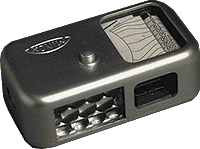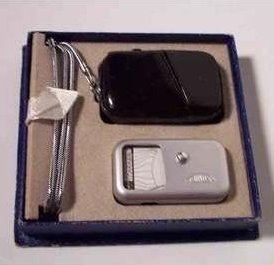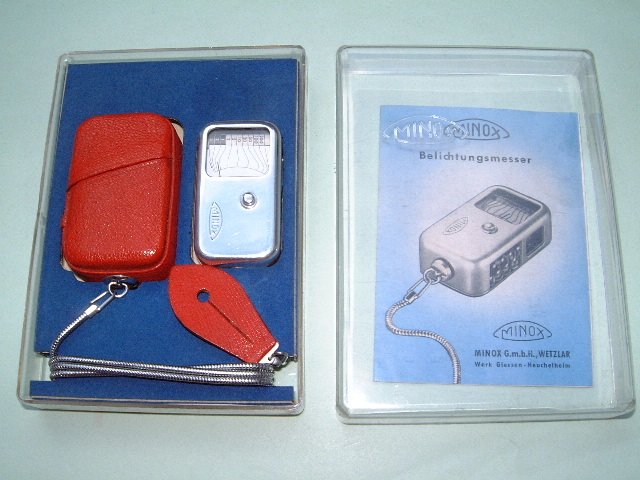Minox 8x11 - Light meters
introduction |
MinoSix Colour coded |
Minosix |
DIN/ASA 10,20,40,80 |
DIN/ASA s/n 10,20,40,80 | DIN/ASA
12,25,50,100 | ASA 12,25,50,100 |
ASA 25, 50, 100,
200 | Black
| Gold | Cases |
Dual Range |
dis-assembled
In 1950 Josef Stüper suggested to Walter Zapp and
E.Pfaffenberger that a special exposure meter be designed for the Minox. When it
appeared in September 1951 the MinoSix was the smallest precision meter in the
world measuring just 53 x 30 x 18mm.
 The
meter has a viewfinder. Early versions have a white line frame, similar to the
camera's. The bubble glass and shade narrow the measuring angle. A
selenium-coated element converts the light into a weak electrical current. The
current flows into a galvanometer which deflects a pointer. The galvanometer has
a jewel bearing and the button on the top releases the pointer to swing freely
by lowering a bar below the counter balance on the needle.
The
meter has a viewfinder. Early versions have a white line frame, similar to the
camera's. The bubble glass and shade narrow the measuring angle. A
selenium-coated element converts the light into a weak electrical current. The
current flows into a galvanometer which deflects a pointer. The galvanometer has
a jewel bearing and the button on the top releases the pointer to swing freely
by lowering a bar below the counter balance on the needle.
The bottom has a thumb dial which is rotated to move the
barrel and it's numbers into place. The top of the barrel has a symbol. The
table on the back shows symbols and reference the film speed. The accompanying
table has readings for f3.5 (centre) and columns headed f2, f2.8, f5.6 and f8.
Whole seconds are silver on black back ground and fractions of a second are
black numbers on a silver background. The conversion table and instructions
enable settings from f1.4 to f32.
 Gossen
in Erlangen, Germany manufactured the electrical components, hence the name Minosix, a combination of Minox and Gossen's trademark "Sixtus". After 1954
Minox sourced these parts from other manufacturers and the the name replaced
with the Minox eye logo.
Gossen
in Erlangen, Germany manufactured the electrical components, hence the name Minosix, a combination of Minox and Gossen's trademark "Sixtus". After 1954
Minox sourced these parts from other manufacturers and the the name replaced
with the Minox eye logo.
The light meter continued to manufactured in small numbers
after the introduction of the Minox B until the early 1960s, mainly for export.
Early light meters have no serial number. The ASA/DIN
scales read ASA 10, 20, 40 and 80 next to a DIN scale 11, 14, 17 and 20, then
ASA 12, 25, 50 and 100. Later models have a scale of ASA 25, 50, 100, 200. One
version, with ASA scale 12, 25, 50, 100 uses colour coded dots instead of the
blank, square, triangle and rectangle symbols.

The final version, from slightly above 90,000, have a dual
scale; white and red which could be selected by a knurled knob at the end of the
meter. The red scale compensated for the orange filter, factor 3.
A black eloxierte and gold plated versions where sold. The
gold plated ones have a black bases and where sold in crocodile cases with
matching fob and a gold chain.
A Plexiglas model with cut out windows on the side and
above the galvanometer was made as a demonstration model.
Minox light meters are mostly sold complete with camera.
Light meters in original boxes are rare.
Last Updated on 23rd October 2005
 The
meter has a viewfinder. Early versions have a white line frame, similar to the
camera's. The bubble glass and shade narrow the measuring angle. A
selenium-coated element converts the light into a weak electrical current. The
current flows into a galvanometer which deflects a pointer. The galvanometer has
a jewel bearing and the button on the top releases the pointer to swing freely
by lowering a bar below the counter balance on the needle.
The
meter has a viewfinder. Early versions have a white line frame, similar to the
camera's. The bubble glass and shade narrow the measuring angle. A
selenium-coated element converts the light into a weak electrical current. The
current flows into a galvanometer which deflects a pointer. The galvanometer has
a jewel bearing and the button on the top releases the pointer to swing freely
by lowering a bar below the counter balance on the needle.
 Gossen
in Erlangen, Germany manufactured the electrical components, hence the name Minosix, a combination of Minox and Gossen's trademark "Sixtus". After 1954
Minox sourced these parts from other manufacturers and the the name replaced
with the Minox eye logo.
Gossen
in Erlangen, Germany manufactured the electrical components, hence the name Minosix, a combination of Minox and Gossen's trademark "Sixtus". After 1954
Minox sourced these parts from other manufacturers and the the name replaced
with the Minox eye logo.
